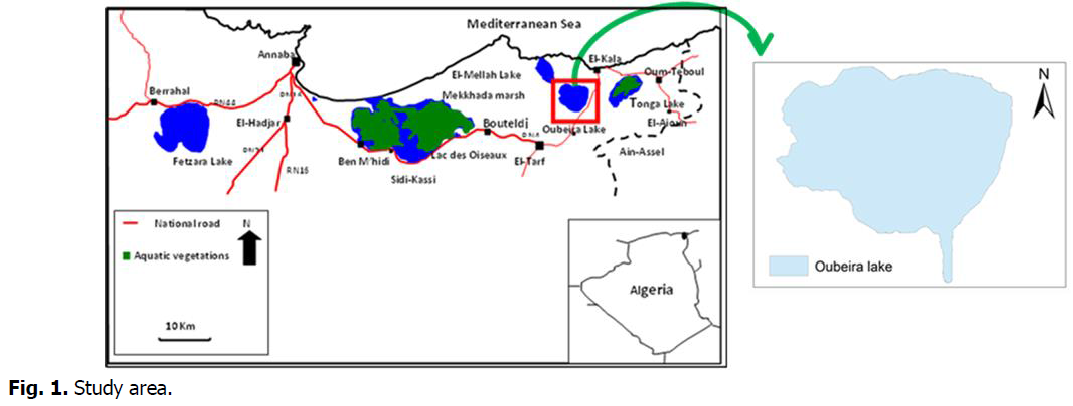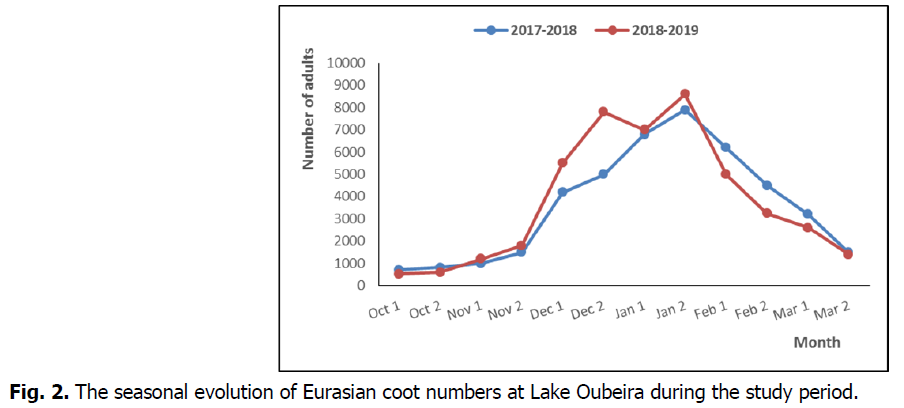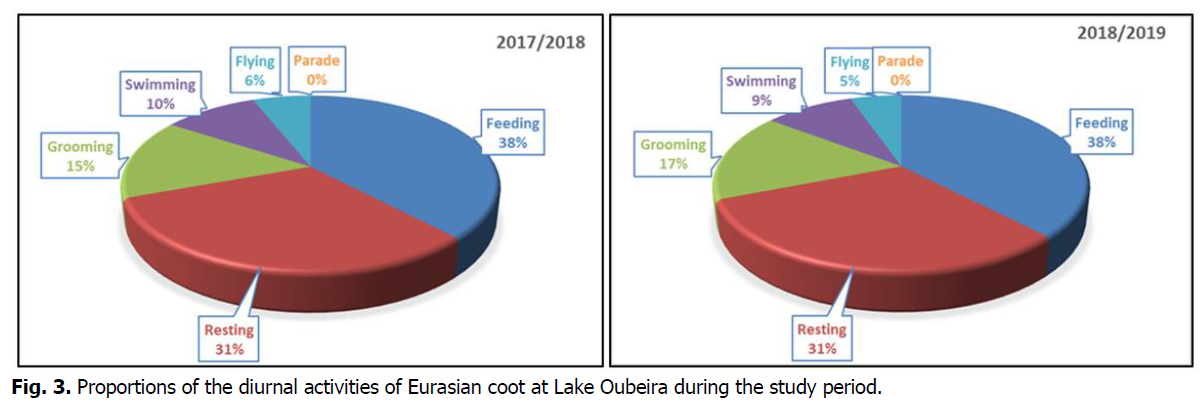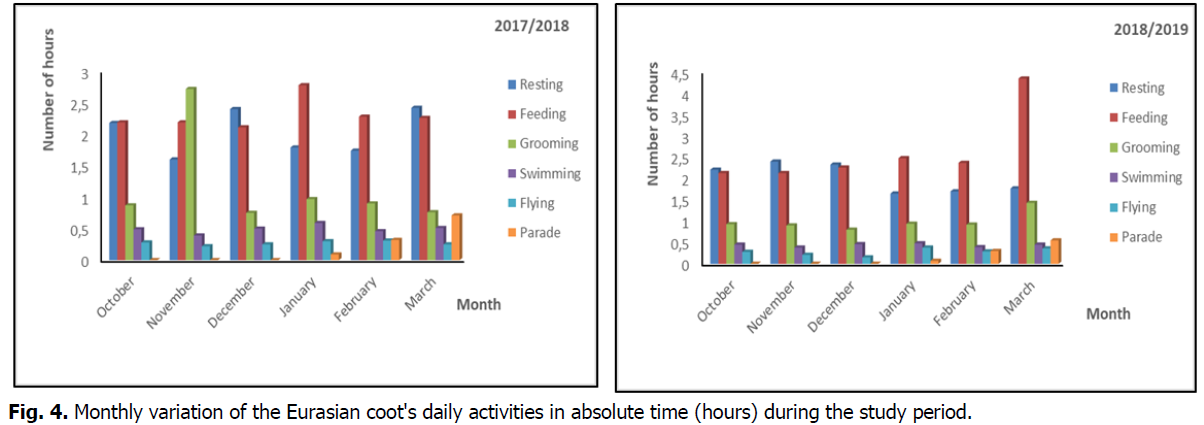Research - (2022) Volume 12, Issue 5
Ecology and diurnal behavior of the Eurasian coot Fulica atra in the Oubeira Lake (Northeastern Algeria)
H. Saidi1, H. Rizi1, A. Baaloudj2* and M. Houhamdi2Abstract
The count of adults of the Eurasian coot carried out over two consecutive winter seasons (between October and March 2017/2018 and 2018/2019) occupying Lake Oubeira (Ramsar site, wilaya of El-Tarf, extreme northeastern Algeria) has shown that the number of individuals fluctuates over time between 520 and 8,600 individuals. The results showed that the Eurasian coot exhibited almost the same diurnal behavior during the two study seasons and was dominated by feeding and resting, which represented more than half of the total time, or (69%). In addition, it should be noted that the diurnal behavior of the Eurasian coot Fulica atra showed that the Lake of Oubeira was used as the resting site for this species.
Keywords
Eurasian coot, wintering, lake oubeira, activity rhythms.
Introduction
The wetlands of north-eastern Algeria are characterized by great biodiversity of fauna and flora (Samraoui and De Belair, 1998; SamraouiandSamraoui, 2008; Bouali et al., 2021). The ecology of waterbirds including their migration, wintering, and their activity rhythms has been extensively studied in several wintering quarters on the northern shores (Goss-Custard, et al., 1977; Pirot, et al., 1984; Allouche et al., 1989; Almara and Amat, 2004). In the South of the Mediterranean, studies are starting to take shape (JACOB and Courbet, 1980; Green and El Hamzaoui, 2000; Houhamdi and Samraoui, 2001, 2002, 2003, 2008; Houhamedi et al., 2008, 2009; Qninba et al. ., 2007; Mayache et al., 2008) and they are focusing more on the reproduction until now(Si Bachir et al., 2000; Radi et al., 2004; Saheb et al., 2006, Samraoui and Samraoui, 2007; Samraoui et al., 2007) in addition to the diet of birds (Si Bachir et al., 2001; 2009; Boukhmza et al., 2004; Houhamdi et al., 2009). Studying the daytime balance of waterbird activities is essential for understanding their ecological needs. These diurnal activities, which vary by species, help us to understand these species' ecological adaptations so as to improve management and conservation planning (Rizi et al., 1999; Bouali et al., 2021). The Rallidae and Anatidae constitute the most important elements both by their specific richness and by their very high numbers (Halassi et al., 2016). These families of waterbirds have been the subject of numerous studies carried out in most of the country's wetlands, such as the work of Boulkhsaiem et al., 2006, Maazi, 2009 and Metallaoui, 2010. The choice of our study fell on this family of water birds and precisely on the Eurasian coot given their characteristics of bioindicators, its conservation status, and its wide distribution in the Algerian wetlands. (Rizi et al., 1999; Samraoui and Samraoui, 2007).
The Eurasian coot Fulica atra is part of the Rallidae family bird, abundant and widespread throughout the wetlands of the high plains (Isenmann and Moali 2000; Houhamdi and Samraoui, 2002; Saheb, 2003; Saheb et al., 2009; Seddik Comm. 2005; Houhamdi et al. 2008), sexually monomorphic, gregarious in winter and territorial during the breeding season (Cramp and Simmons, 1980). In Algeria, this species’ nesting and sedentary status are very common and widely distributed (Rizi et al., 1999), and it is classified by the IUCN as a near-in danger species (Birdlife International, 2004; IUCN, 2006). It is an excellent biological model that can prove to be a very good biological marker of the structure and functioning of hydro systems (Rizi et al., 1999; Haouam, 2003; Abdi et al., 2016). The present investigation aims to deepen the eco-ethological knowledge of the two wintering seasons of the Eurasian coot (Fulica atra) in the most important natural wetland of the eco-complex of the wilaya of El Taref through the phenology, the diurnal rhythm, and the structure of the numbers of this species in order to determine its wintering strategy in the Lake of Oubeira (north-eastern Algeria).
Materials and Methods
Study area
The Lake of Oubeira is a Ramsar site of international importance within El Kala National Park. It is a freshwater lake with an area of 2200 ha, its depth does not exceed 2 m. (Fig. 1). It has been classified as a Ramsar site since 1982. The character of freshwater and the diversity of ancillary environments is at the origin of the presence of abundant and specific resources; it is covered by emergent vegetation such as Typha latifolia, and Scirpus lacustris and includes a rare species Trapa satans of the unique the Lake of Oubeira in North Africa. This site is important for breeding and wintering waterbirds, especially for the Anatidae and Rallidae families. During the winter, this wet site hosts nearly 50,000 birds of various species. As such, it constitutes a privileged area for the migration of avifauna to the region. (Brahmia, 2002).

Fig 1: Study area.
Sampling
Our study was carried out on wintering over two successive years 2017/2018 and 2018/2019 at Lake Oubeira. The population count of the Eurasian coot was carried out by the estimation method.
During our counts, we proceeded to an individual count when the band of Fulicaatra is close to our point of observation and of size less than 200 individuals, otherwise we proceeded as follows: we count the most exactly possible at one end of the band of birds a batch according to the size of the group (10, 50, 100) then we transfer as many times as necessary on the rest of the band the area represented by our reference group. (Blondel, 1969 in Shrike, 1985). The margin of error for this method is in the order of 5-10% (Lamotte and Bourliere, 1969).
Concerning the diurnal activity rhythm of the species, we chose the SCAN method carried out every hour, from 9 am to 4 pm (Boulekhssaim et al., 2006; Tamisier and Dehorter, 1999). The activities tracked are eating, resting, swimming, grooming, flying, and parrying. (Metallaoui et al., 2009; Bouali et al., 2021). Observations were made remotely using a telescope (KOWA 20 × 60) and a pair of Kite Pallas binoculars (10 × 42), from points on the shores of Lake Oubeira.
Results
Wintering phenology
Fulica atra occupies the Lake of Oubeira during both wintering seasons with numbers varying from month to month and also during breeding. During our study period, monitoring the count of adult of Eurasian coots in the Lake of Oubeira showed us that coots occupy this site from the end of September to early October. The population fluctuated between 700 to 820 individuals in the first year of study and from 520 to 600 in the second year (Fig. 2). The number of Eurasian coot gradually increased until January when the species peaked at 7,900 and 8,600 individuals for the two seasons (2017/2018), and (2018/2019) respectively.

Fig 2: The seasonal evolution of Eurasian coot numbers at Lake Oubeira during the study period.
Subsequently, a sharp drop in numbers towards the end of March (1500 and 1400 individuals) was recorded, which is consistent with the start of the breeding season of Fulica atra. This confirms the movement of species to other humid sites following the sudden drop in water level and with their fall migration to effective wintering grounds.
Study of the rhythm of daytime activities
Daytime budget activities recorded by Eurasian Coot in the Lake of Oubeira and throughout the study period indicate that both activities predominate (both wintering seasons) "2017/2018; 2018/2019 "is feeding (36%; 33%) and resting (34%, 35%) respectively. These activities followed grooming (16%) and swimming (8%), and finally a small proportion of the activity of flying. During the wintering period, it is much more observed on foot in the mud flats and on the banks, on the other hand during the reproduction period, it is noted in the water where the bird prefers to feed by seeking its food by immersion of its beak or head (Fig. 3).

Fig 3: Proportions of the diurnal activities of Eurasian coot at Lake Oubeira during the study period.
The study of the balance sheet of the daily rhythm of activities of the Eurasian coot also shows that food and rest are the activities that dominate throughout the day, the peak of which is recorded in March with an average of 5 hours and 6 hours for the two activities and for the two seasons (2017/2018, 2018/2019) respectively, this result corresponds to the start of the nesting period of the species, while the other activities not reaching one hour of average time (Fig. 4).

Fig 4: Monthly variation of the Eurasian coot's daily activities in absolute time (hours) during the study period.
The study of the monthly balance sheet of the rhythm of daytime activities shows that the Eurasian coot spends more than 70% of its time feeding and resting during the two study seasons, the peak of which was recorded in December with (74.13%) for the (2017/2018) season and (76.46%) for the (2018/2019) season. The curve of this activity shows that the Eurasian coot spent its time in nutrition during most of the wintering period (Fig. 5).

Fig 5: Temporal variation in the diurnal activities of Eurasian coot during the study period.
Grooming comes third in the daytime activity rate of Eurasian coot, Other activities occupy only a small proportion of the Eurasian coot's daytime budget <10%.
Discussion
The Eurasian coot Fulica atra is a very common sedentary nesting species (Rizi et al., 1999). Frequent all types of wetlands and especially the wetlands of the high plains of eastern Algeria throughout the annual cycle with numbers varying from month to month and also during wintering or reproduction (Samraoui and Samraoui, 2007; (Baaziz and Samraoui, 2008).
The study of the seasonal evolution of the Eurasian coot population showed that the maximum wintering population of Eurasian coot was estimated at 7,900 and 8,600 individuals in January for the two seasons (2017/2018; 2018/2019) respectively. These peaks in number are explained by the massive arrival of migratory birds. In addition, the number of Eurasian Coot appears to differ from site to site and from year to year. One of the possible reasons for these differences in number is the terrain (climatic conditions, adequate water depth, and quality (Salathé and Boy, 1987). Good knowledge of the terrain is certainly essential to obtaining reliable results.
Analysis of monthly variations in abundance shows that the highest values were recorded during the winter period, following the arrivals of wintering populations. (Baaziz, 2008, 2011; Benradia et al., 2018).
The decrease in the workforce at the end of the study can be explained in a non-exclusive way by the unfavorable climatic conditions, characterized by the drying out of sites. This confirms the work of Samraoui and Samraoui (2007).
The seasonal evolution of the Eurasian coot's daytime activities also shows that diet and rest dominate throughout the study period followed by Grooming while other activities occupy a small percentage.
These results confirm those previously recorded by Allouche (1988) in France and that of Tamisier and Déhorter (1999) in the Camargue and it partially resembles that found by Baaziz (2008) at garaet Timerganine, on the contrary, our results are higher compared to that noted by (Rizil, et al., 1999), we notice that the flight and the display occupy a minimal part in the diurnal rhythm verifying that with the least threats, this Rallidae prefers to swim than to fly (Allouche, 1990).
Conclusion
This study carried out over two successive years 2017/2018 and 2018/2019 at the Lake of Oubeira, (north-eastern Algeria) helped us to study the structure, phenology, and diurnal behavior of the Eurasian coot Fulica atra.
The presence throughout the study period of the Eurasian coot gives it the phenological status of a sedentary species. The study of the rhythms of diurnal activities has shown that the total balances in all the sites are dominated by food and rest. Therefore, the lake of Oubeira constitutes an ideal refuge for the reception of this species and plays an important role in the diurnal delivery of the totality of Algerian wetlands (Houhamdi and Samraoui 2001, 2003, 2008; Rizi et al., 1999; Bouali et al., 2021).
The study of the diurnal activity rhythm of this species deserves to be supplemented by the nocturnal behavior which could make it possible to better understand the variation of its activity rhythms and also to know its ecological requirements and its wintering strategy.
To this end, it is essential to establish an action plan for the management of this ecosystem which will be based on a protection strategy for this species in order to ensure the maximum sustainability of plant and animal biodiversity and to raise awareness among the community and to the requirements of preserving this animal wealth and their natural habitats.
Acknowledgments
We thank the reviewers for their comments and suggestions. We thank all the inhabitants of Lake Oubeira for their help as well as that of the El Kala National Park. We thank the MERS and the DGRSDT for supporting and funding this work.
References
Abdi, S., Merzoug, S., Tabouche, K., Maazi, M.C., Houhamdi, M. (2016). Structure des effectifs et stationnement hivernal du Fuligule nyroca Aythya nyroca dans le complexe de zones humides de Guerbes-Sanhadja (Nord-est algérien). Bulletin de la Société Zoologique de France, 141:91-102.
Allouche, L. (1990). Stratégies d’hivernage comparées du canard Chipeau et de la Foulque macroule pour un partage spatio-temporel des milieux humides de Camargue.
Allouche, L., Dervieux, A., Lespinasse, P., Tamisier, A. (1989). Sélection del’habitat diurne par trois espèces d’oiseaux d’eau herbivores hivernant en Camargue (France). Acta Oecologica. Oecologia Applicata, 10:197-212.
Baaziz, N. (2008). Contribution to the study of wintering and reproductive strategies of common coots (Fulicaatra) and anatidae across the hautsplateaux of Northeast Algeria.
Baaziz, N., Mayache, B., Saheb, M., Bensaci, E., Ounissi, M., Metallaoui, S. (2011). Statut phénologique et reproduction des peuplements d’oiseaux d’eau dans l’éco-complexe de zones humides de Sétif (Hauts plateaux, Est de l’Algérie). Bulletin de l’Institut Scientifique de Rabat, 32:77-87.
Baaziz, N., Samraoui, B. (2008). The status and diurnal behavior of wintering Common Coot Fulicaatra L. in the hautsPlateaux, northeast Algeria. The European Journal of Scientific Research, 23:495-512.
Benradia, M., Menaa, M., Guellati, K., Maazi, M.C., Bouslama, Z., Houhamdi, M. (2018). Premières données sur les Anatides et les Foulques macroules fulica atra dans les zones humides de la wilaya de Souk-ahras (extreme nord-est de l’algerie). Bulletin de la Société Zoologique de France, 143:145-169.
van Bommel, F. (2004). Birds in Europe: population estimates, tends andconservation status. Cambridge, UK: Bird Life International. 12:374.
Bouali, N., Baaloudj, A., Touarfia, M., Houhamdi, I., Maazi, M.C., Houhamdi, M. (2021). Ecology, phenology and wintering behavior of Anatidae in the wetlands of Souk-Ahras (north-eastern Algeria). Arxius de Miscel lània Zoològica, 19:135-149.
Boukhemza, M., Doumandji, S., Voisin, C., et Voisin, J.F. (2004). Comparative utilization pattern of trophic ressources by white storjs ciconia ciconia and cattle egrets bubulcus ibis in kabylia (Algeria). Revue d’écologie (Terre et Vie), 59:559-580.
Boulkhssaim, M., Houhamdi, M., Saheb, M., Samraoui-Chenafi, F., Samraoui, B. (2006). Breeding and banding of greater flamingo phoenicopterus roseus in Algeria. Flamingo, 14:21-24.
Brahmia, Z. (2002). Rôle fonctionnel du lac Oubeira et du lac Mellah (parc national d’El-Kala) pour les oiseaux marins. Thèse de magistère. Université Badji Mokhtar Annaba.
Cramp, S.L., Simmons, K.E.L. (1980). The birds of the western paleartic. Hawks to Bustards, Oxford University Press, London.
Green, A.J., El-Hamzaoui, M. (2000). Diurnal behaviour and habitat use of nonbreeding Marbled Teal, Marmaronetta angustirostris. Canadian Journal of Zoology, 78:2112-2118.
Halassi, I., Elafri, A., Belhamra, M., Houhamdi, M. (2016). Répartition et abondance de l’Erismature à tête blanche Oxyura leucocephala dans les zones humides du Nord-Est algérien. Alauda 84:23-32.
Haouam, L. (2003). Ecologie et reproduction des Rallidés de la Numidie. Mémoire d’ingénieur d’état en Ecologie et Environnement, p:76.
Houhamdi, M., Samraoui, B. (2001). Diurnal time budget of wintering Teal Anas crecca at Lac des oiseaux, northeast Algeria. Wildfowl, 52:87-96.
Houhamdi, M., Et-Samraoui, B. (2002). Occupation spatio-temporelle par l’avifaune aquatique du lac des oiseaux (Algérie). Alauda, 70:301-310.
Houhamdi, M., Et-Samraoui, B. (2008). Diurnal and nocturnal behaviour of ferruginous duck Aythya nyroca at lac des oiseaux, North east Algéria. Ardeola, 55:59-69.
Houhamdi, M., Hafid, H., Seddik, S., Bouzegag, A., Nouidjem, Y., Bensaci, T., Maazi, M.C., et Saheb, M. (2008). Hivernage des Grues cendrées (Grus grus) dans le complexe de zones humides des hautes plaines de l‟Est de l‟Algérie.
Houhamdi, M., Maazi, M.C., Seddik, S., Bouaguel, L., Bougoudjil, S., Saheb, M. (2009). Statut et écologie de l’Érismature à tête blanche Oxyuraleucocephala dans les zones humides des hautes plaines de l’Est algérien. Aves, 46:129-148.
Isenmann, P., Moali, A. (2000). Oiseaux d'Algérie. Birds of Algeria. Société d'Etudes Ornithologiques de France, Paris, France.
IUCN. (2006). IUCN Red List of ThreatenedSpecies. Version 2006.
Jacob, J.P., Courbet, B. (1980). Oiseau de mer nicheur sur la côte algérienne. Le Gerfaut, 70:385-401.
Lamotte, J., Et-Bourliere, A. (1969). Problèmes d’écologie: l’échantillonnage des peuplements animaux des milieux terrestres. Paris: Masson.
Maazi, M.C. (2009). Eco éthologie des anatidés hivernant dans la GaraetdeTimerganine (Ain Zitoun-Oum el Bouaghi).Thèse de Doctorat. Université Badji Mokhtar, Annaba, p:159.
Mayache, B., Houhamdi, M., Samraoui, B. (2008). Ecologie des Sarcelles d’hiver Anas creccacrecca L. hivernants dans l’éco-complexe de zones humides de Jijel (Nord-Est de l'Algérie). Editorial Advisory Board, 21:104-119.
Metallaoui, S., Atoussi, S., Merzoug, A., Houhamdi, M. (2009). Hivernage de l’Érismature à tête blanche (Oxyuraleucocephala) dans Garaet Hadj-Tahar (Skikda, Nord-Est de l’Algérie). Aves, 46:136-140.
Metallaoui, S., (2010). Ecologie de l’avifaune aquatique hivernante dans Garaet Hadj-Tahar (Numidie occidentale, Nord-Est de l’Algérie).
Pirot, J.Y., Chessel, D., et-Tamisier, A. (1984). Exploitation alimentaire des zones humides de Camargue par 5 espèces de canards de surface en hivernage et en transit:Modélisationspatio-temporelle. Revue d’Ecologie (Terre et Vie), 39:167-192.
Qninba, A., Dakki, M., Benhoussa, A., El-Agbani, M.A. (2007). Rôle de la côte marocaine dans l’hivernage des limoicoles (Aves, Charadrii). Ostritch, 78:489-493.
Rizi, H., Benyacoub, S., Chabi, Y., Banbura, J. (1999). Nesting and reproductive characteristics of Coots Fulicaatra breeding on two lakes in Algeria. Ardeola, 46:179-186.
Saheb, M. (2003). Cartographie de la végétation des sebkhas de Guellif et de Boucif (Oum el Bouaghi) et écologie de l’avifaune aquatique. Thèse magister, C.U. Larbi ben M’hidi, Oum el Bouaghi, p:56.
Saheb, M., Boulekhssaim, M., Ouldjaoui, A., Houhamdi, M., Samraoui, B. (2006). Nidification du flamant rose Phoenicopterusroseus en 2003 et 2004 en Algérie. Alauda, 74:368-371.
Saheb, M., Bouzegag, A., Nouidjem, Y., Bensaci, T., Samraoui, B., Houhamdi, M. (2009). Ecologie de la reproduction de l’Avocette élégante Recurvirostraavosetta dans la Garaet de Guellif (Hautes plaines de l’Est algérien). European Journal of Scientific Research, 25:513-525.
Salathé, T., Boy, V. (1987). Territoriality and time budget of breeding coots. Wildfowl, 38:70-76.
Samraoui, B., Et-De Belair, G. (1998). Les zones humides de la Numidie orientale: Bilan des connaissances et perspectives de gestion. Synthèse (Numérospécial), p:90.
Samraoui, F., Samraoui, B. (2007). the reproductive ecology of the common coot (Fulicaatra) in the Hauts Plateaux, Northeast Algeria. Waterbirds, 30:133-139.
Samraoui, F., Menaï, R., Samraoui, B. (2007). Reproductive ecology of the Cattle Egret (Bubulcus ibis) at Sidi Achour, north-eastern Algeria. Ostrich, 78:481-487.
Samraoui, B., Samraoui, F. (2008). An ornithological survey of Algerian wetlands: Important bird areas, Ramsar sites and threatened species. Wildfowl, 58:71-98.
Schricke, V. (1985). Modalités d’utilisation de l’espace par les canards de surface en période d’hivernage et de migration dans la baie du Mont Saint-Michel.
Seddik, S. (2005). Occupation spatio-temporelle des peuplements Laro-Limicoles et Echassiers dans les zones humides des hautes plaines de l’Est algérien. Mémoire de Magister, Université d’Oum El-Bouaghi, p:78.
Si Bachir, A., Hafner, H., Tourenq, J.N., Doumandji, S. (2000). Structure de l’habitat et biologie de reproduction du Héron garde boeufs, Bubulcus ibis, dans une colonie de la vallée de la Soummam (Petite Kabylie, Algérie). Revue d’Ecologie (Terre et vie), 55:33-43.
Si Bachir, A., Hafner, H., Tourenq, J.N., Doumandji, S., Lek, S. (2001). Diet of the adult Cattle egret (Bubulcus ibis L.) in a new north african colony (Petite Kabylie, Algérie): taxonomic composition and variability. Ardeola, 48:217-223.
Tamisier, A., Et-Dehorter, O. (1999). Camargue, Canards et Foulques. Fonctionnement d’un prestigieux quartier d’hiver. Centre Ornithologique du Gard. Nîmes, p:369.
Author Info
H. Saidi1, H. Rizi1, A. Baaloudj2* and M. Houhamdi22Laboratoire Biologie, Eau et Environnement (LBEE), University 8 Mai 1945 Guelma, BP-401 24000, Guelma, Algeria
Citation: Saidi, H., Rizi, H., Baaloudj, A., Houhamdi, M. (2022). Ecology and diurnal behavior of the Eurasian coot Fulica atra in the Oubeira Lake (Northeastern Algeria). Ukrainian Journal of Ecology. 12:70-75.
Received: 06-Jun-2022, Manuscript No. UJE-22-66044; , Pre QC No. P-66044; Editor assigned: 08-Jun-2022, Pre QC No. P-66044; Reviewed: 20-Jun-2022, QC No. Q-66044; Revised: 25-Jun-2022, Manuscript No. R-66044; Published: 30-Jun-2022, DOI: 10.15421/2022_377
Copyright: This is an open access article distributed under the terms of the Creative Commons Attribution License, which permits unrestricted use, distribution, and reproduction in any medium, provided the original work is properly cited.
